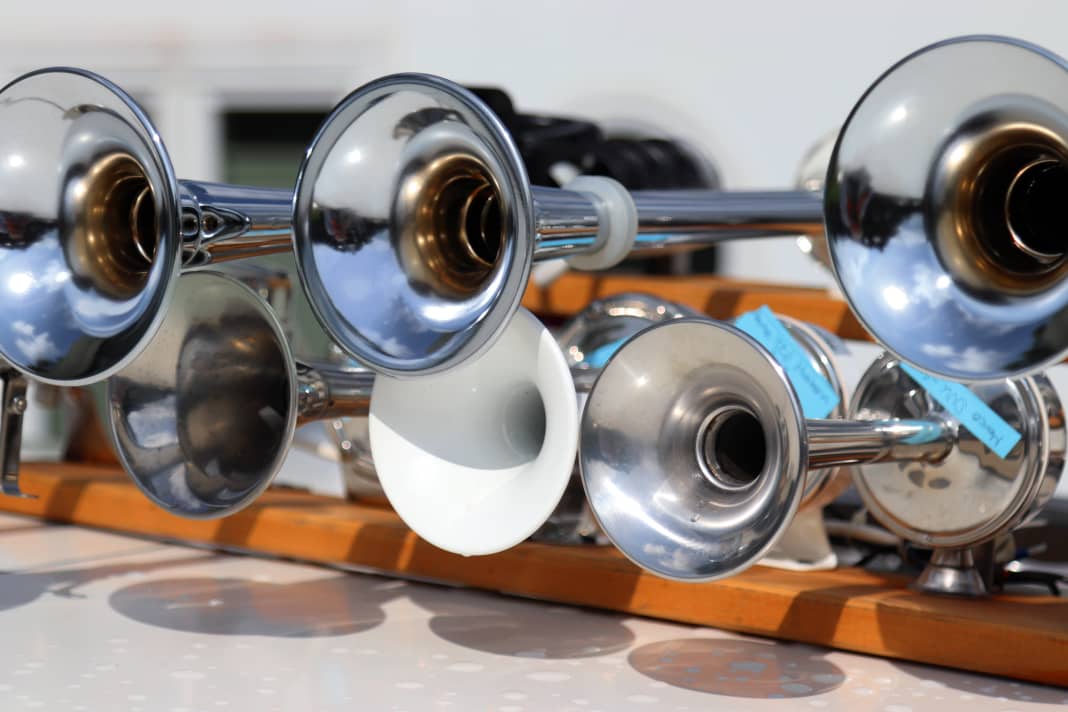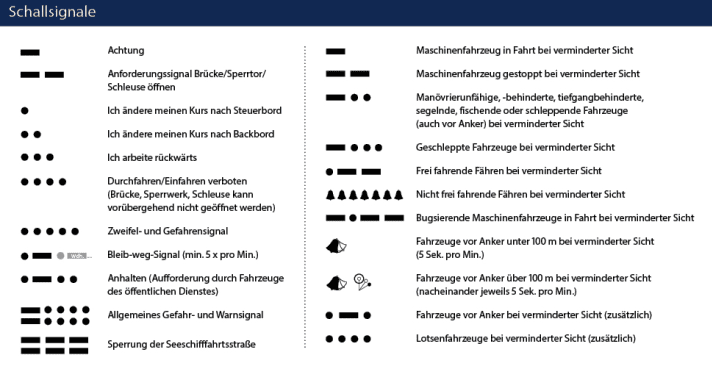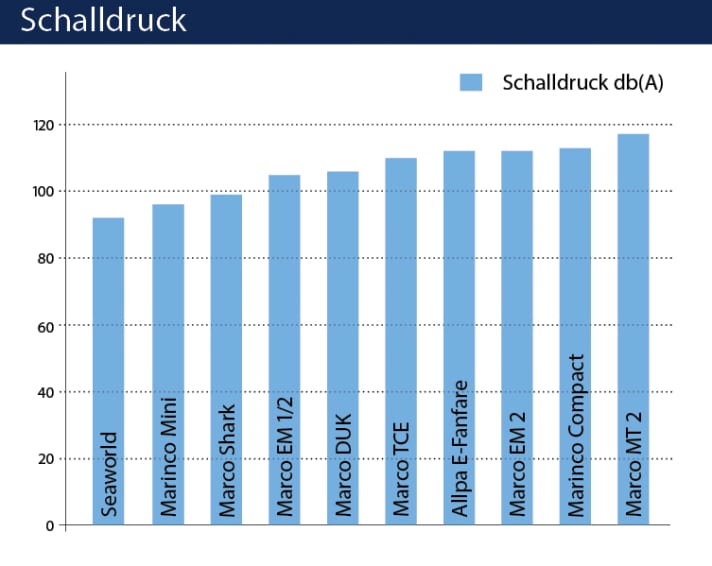





A so-called sound signalling device, i.e. a signal horn, should be present on every boat. It is even mandatory in sea areas. Most shipyards fit electric horns as standard on small and medium-sized boats up to around 8 metres in length. The advantage: they are inexpensive, small and easy to install almost anywhere.
In practice, however, electric horns are often unpleasant: too quiet, defective after just a few years - this is the common experience of many boaters. The problem is often not the device itself, but incorrect installation. If you visualise how it works, it quickly becomes clear that water, especially salt water, is the natural enemy of an electromagnetic horn. If it can penetrate the horn, its days are inevitably numbered.
Therefore: When installing the horn, you should take great care to ensure that neither rain nor splash water can penetrate through the horn into the interior of the horn, for example by tilting the horn slightly downwards. If this is guaranteed, an electric horn will last for many years.
The function
Electric horns work according to the principle of the "Wagner hammer". In plain language: The applied electrical voltage magnetically attracts a spring-loaded metal cylinder - the hammer, to which the sound membrane is also attached. An interrupter contact mounted in parallel stops the current flow again after a very short time, so that the hammer is pushed back into its original position by the spring.

This constantly repeating process generates a vibration that is emitted from the sound membrane into the air and is perceived from the outside as a honking sound. If the simple sound membrane is combined with an air funnel, the fundamental tone (usually a lower frequency) is amplified and the horn sounds deeper and therefore fuller. Experts call this arrangement an "electrofanfare". With the exception of the Marinco Mini (simple metal diaphragm), all the models tested here work according to the fanfare principle described.
Back to the test. In order to work out the differences between the various models, particularly in terms of the sound pressure generated, we pitted ten different electric horns from the aftermarket against each other under practical conditions. These were Marinco Mini, Allpa E-Fanfare, Marco Shark SK 1Marco MT 2, Marco TCE Mini, Marco DUK, Marco EM 2, Marinco CompactIt is important to note that the horn tested here as the Allpa E-Fanfare is identical to the Marco MT 2 horns. The same applies to the Marco EM 2, which can also be found as part of the double fanfare on the Marco EM 1 /2.
The dimensions
The first part of the test focussed on the dimensions and mounting options. The smaller models Marinco Mini, Allpa E-Fanfare, Marco Shark and Marco MT 2 scored particularly well here, measuring a maximum of 12 x 10 cm. All of these horns are so compact that they can be easily accommodated on almost any boat.
Marco TCE Mini and Marco DUK require slightly more mounting space. The funnels are around 25 cm long, but are still easy to fit even on smaller boats. With a funnel length of 46 cm, the Marco EM 1/2 double horn is the largest model in this test field and requires considerably more space on board.
The sound pressure
We decided to measure the sound pressure in two ways. Firstly, at a distance of one metre, which corresponds to the manufacturer's specifications. Secondly, we measured the sound pressure at a distance of around 25 metres to get an impression of the horns' suitability for practical use. For the power supply, we used a conventional 12 V on-board battery with a cable length of around one metre - in other words, optimum conditions that are rarely implemented on board.

At a distance of one metre, the Marco MT 2 double horn achieved the best, because loudest, value at 117 db(A). Marinco Compact (113 db(A)), Marco EM 2 (112 db(A)) and Allpa E-Fanfare 112 db(A)) followed with around 4 db less. Also good were: Marco TCE Mini (110 db(A)), Marco DUK (106 db(A)) and the double horn Marco EM 1/2 (105 db(A)). The worst performers at a distance of one metre were the Seaworld horn (92 db(A)) and the Marinco Mini (96 db(A)). In addition, the Seaworld horn sometimes misfired.
A similar picture emerged at a measuring distance of 25 metres. Here too, the Marco double horn MT 2 was ahead of all others with around 90 db(A). It was followed by the (identical) Allpa-E single fanfare with 87 db(A) and the Marinco Compact with 86 db(A). At 65 db(A) and 68 db(A) respectively, the Seaworld horn and the Marinco Mini were barely perceptible as signalling devices. Practical experience showed that all values below 75 db(A) at a distance of 25 metres had virtually no alarming effect and were drowned out by the normal ambient noise.
Also interesting:
The reason: the sound pressure decreases rapidly with distance after leaving the sound emitter. Theoretically, the value drops from 120 db at a distance of one metre, for example, to 96 db at a distance of 16 metres. If the measuring distance is increased to 100 metres, for example, hardly more than one percent of the original value remains.
The pitch
Opinions differ when it comes to frequency, i.e. the pitch of the signal. While some prefer the lowest possible tone, comparable to that of a commercial ship's typhoon (fog horn), others favour the penetrating effect of a higher tone. Our measurements show that the lower tones of our test horns (just below 1000 Hz) are not necessarily more audible than high tones.
This effect only comes into play at very low frequencies (below 200 Hz), such as those used in large ships. Here, however, the sound pressures generated are more than 140 db(A), which enables ranges of up to three nautical miles.

The lowest frequency in our test was delivered by the Marco MT 2 at 800 Hz, while the highest sound was produced by the Marinco Compact at 1700 Hz. If you compare the sound pressures of these two, you can see that they are almost identical at a distance of 25 metres. All other test horns were somewhere in between with values between 880 Hz and 1500 Hz.
The bottom line
The test winner in terms of sound pressure and price-performance ratio is clearly the Marco MT 2 double horn, provided by AW Niemeyer for our test. Those who prefer the look of a real funnel horn will be well served by the Marinco Compact or the Marco EM 2. These are hardly any quieter, but cost around 40 euros more.
The Marinco Mini, also from AW Niemeyer, brings up the rear in our comparison. A maximum sound pressure level of 96 db(A) at a distance of one metre is clearly too low, and even the compact dimensions and price of just under 30 euros can't change the test ranking.
All in all, however, it can be said that electric horns are better than their reputation. The test winners in this comparison can certainly hold their own against compressor fanfares.

